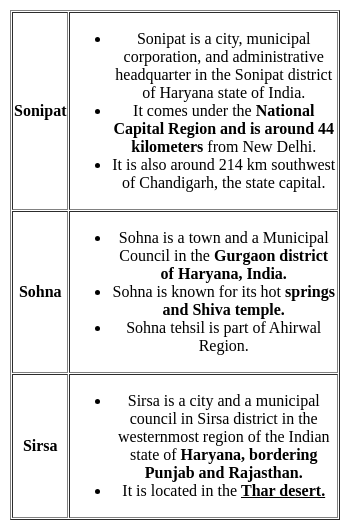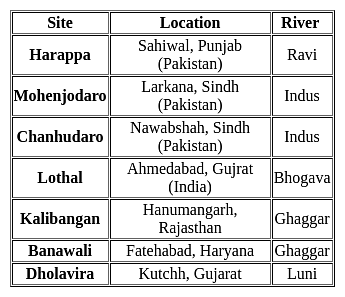Software Development Exam > Software Development Tests > Test: Ancient History of Haryana - Software Development MCQ
Test: Ancient History of Haryana - Software Development MCQ
Test Description
20 Questions MCQ Test - Test: Ancient History of Haryana
Test: Ancient History of Haryana for Software Development 2025 is part of Software Development preparation. The Test: Ancient History of Haryana questions and answers have been prepared
according to the Software Development exam syllabus.The Test: Ancient History of Haryana MCQs are made for Software Development 2025 Exam.
Find important definitions, questions, notes, meanings, examples, exercises, MCQs and online tests for Test: Ancient History of Haryana below.
Solutions of Test: Ancient History of Haryana questions in English are available as part of our course for Software Development & Test: Ancient History of Haryana solutions in
Hindi for Software Development course.
Download more important topics, notes, lectures and mock test series for Software Development Exam by signing up for free. Attempt Test: Ancient History of Haryana | 20 questions in 20 minutes | Mock test for Software Development preparation | Free important questions MCQ to study for Software Development Exam | Download free PDF with solutions
Test: Ancient History of Haryana - Question 1
Which ancient city of Haryana was known as ‘Sarpadaman’?
Detailed Solution for Test: Ancient History of Haryana - Question 1
Test: Ancient History of Haryana - Question 2
Mithathal famous for the remains of Indus Civilization is situated in
Detailed Solution for Test: Ancient History of Haryana - Question 2
Test: Ancient History of Haryana - Question 3
With reference to the ancient culture & civilization of India, which of the following sites of the Indus Valley Civilization is in Haryana?
Detailed Solution for Test: Ancient History of Haryana - Question 3
Test: Ancient History of Haryana - Question 4
The compositions of Poet Pushpadant are related to which sect
Detailed Solution for Test: Ancient History of Haryana - Question 4
Test: Ancient History of Haryana - Question 5
Maharaja Agrasena was associated with which place?
Detailed Solution for Test: Ancient History of Haryana - Question 5
Test: Ancient History of Haryana - Question 6
Banawali ancient site is located in which district of Haryana?
Detailed Solution for Test: Ancient History of Haryana - Question 6
Detailed Solution for Test: Ancient History of Haryana - Question 7
Test: Ancient History of Haryana - Question 8
Which type of coins have been discovered form the mounds of Hisar and Agroha?
Detailed Solution for Test: Ancient History of Haryana - Question 8
Test: Ancient History of Haryana - Question 9
Rohtak district got its mention in which historical text?
Detailed Solution for Test: Ancient History of Haryana - Question 9
Test: Ancient History of Haryana - Question 10
Which of the following Harappan sites is in Haryana?
Detailed Solution for Test: Ancient History of Haryana - Question 10
Test: Ancient History of Haryana - Question 11
In which of the following district of Haryana, have the 'Ashoka edicts' been found?
Detailed Solution for Test: Ancient History of Haryana - Question 11
Test: Ancient History of Haryana - Question 12
Who called the Brahma Sarovar of Haryana as a miniature sea?
Detailed Solution for Test: Ancient History of Haryana - Question 12
Test: Ancient History of Haryana - Question 13
Which city of Haryana is associated with Karna of Mahabharata?
Detailed Solution for Test: Ancient History of Haryana - Question 13
Test: Ancient History of Haryana - Question 14
By excavations done in which of the following historical towns of Sonepat district, earthen utensils belonging to Mahabharata period have been found?
Detailed Solution for Test: Ancient History of Haryana - Question 14
Test: Ancient History of Haryana - Question 15
Great epic Mahabharata was composed by Maharshi Ved Vyas in which of the following towns of Haryana?
Detailed Solution for Test: Ancient History of Haryana - Question 15
Test: Ancient History of Haryana - Question 16
During ancient times, Bahadurgarh town of the state was known as
Detailed Solution for Test: Ancient History of Haryana - Question 16
Test: Ancient History of Haryana - Question 17
During ancient times, Gohana town of the state was known as
Detailed Solution for Test: Ancient History of Haryana - Question 17
Test: Ancient History of Haryana - Question 18
During the Mahabharata period Sirsa was known as
Detailed Solution for Test: Ancient History of Haryana - Question 18
Detailed Solution for Test: Ancient History of Haryana - Question 19
Test: Ancient History of Haryana - Question 20
During ancient times, Mahendragarh town of this state was known as
Detailed Solution for Test: Ancient History of Haryana - Question 20
Information about Test: Ancient History of Haryana Page
In this test you can find the Exam questions for Test: Ancient History of Haryana solved & explained in the simplest way possible.
Besides giving Questions and answers for Test: Ancient History of Haryana, EduRev gives you an ample number of Online tests for practice
Download as PDF




















